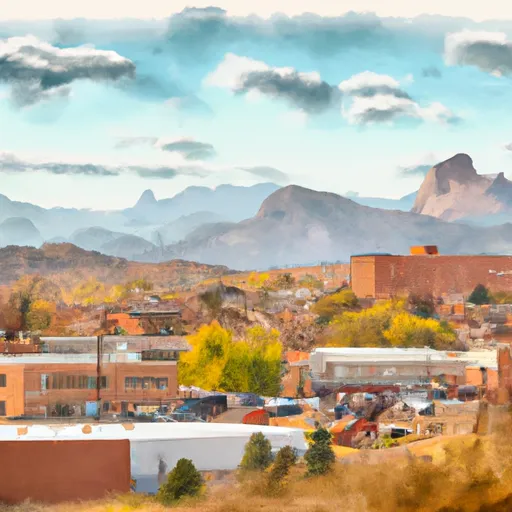-
 Snoflo Premium
Snoflo Premium
Get unlimited access to all our content
With no Ad interruptions! - Start Your Free Trial Login with existing account
Monument
Eden Index
Climate
8.0
•
Recreation
6.9
•
Community
5.3
•
Safeguard
6.9/10

Monument, Colorado is a charming town located at an elevation of approximately 7,500 feet in El Paso County. The climate in Monument is classified as a semi-arid climate, characterized by warm summers and cold winters. Summers are generally mild with temperatures ranging from the mid-70s to low 80s Fahrenheit, while winters can be chilly with temperatures dropping to the 20s and occasional snowfall.
The town is situated near the Palmer Divide, which influences its hydrology constituents. Monument Creek flows through the area, providing a valuable water source. The creek is also surrounded by picturesque rock formations, contributing to the natural beauty of the region.
Outdoor recreation opportunities are abundant in Monument. The town is nestled among the Rocky Mountains, offering easy access to hiking, mountain biking, and camping. The nearby Pike National Forest provides opportunities for fishing, hunting, and exploring the great outdoors. Monument is also home to several parks and open spaces, perfect for picnicking and enjoying nature. With its stunning scenery and diverse outdoor activities, Monument, Colorado is a haven for nature enthusiasts and adventure seekers.
What is the Eden Index?
The Snoflo Eden Index serves as a comprehensive rating system for regions, evaluating their desirability through a holistic assessment of climate health, outdoor recreation opportunities, and natural disaster risk, acknowledging the profound impact of these factors on livability and well-being.
Climate Health Indicator (CHI): 8.0
Monument receives approximately
575mm of rain per year,
with humidity levels near 72%
and air temperatures averaging around
8°C.
Monument has a plant hardyness factor of
5, meaning
plants and agriculture in this region thrive during a short period during spring and early summer. Most
plants will die off during the colder winter months.
By considering the ideal temperature range, reliable water supplies, clean air, and stable seasonal rain or snowpacks, the Climate Health Indicator (CHI) underscores the significance of a healthy climate as the foundation for quality living.
A healthy climate is paramount for ensuring a high quality of life and livability in a region, fostering both physical well-being and environmental harmony. This can be characterized by ideal temperatures, reliable access to water supplies, clean air, and consistent seasonal rain or snowpacks.
Weather Forecast
Streamflow Conditions
Upper Arkansas
Area Rivers
Upper Arkansas
Snowpack Depths
Upper Arkansas
Reservoir Storage Capacity
Upper Arkansas
Groundwater Levels
Recreational Opportunity Index (ROI): 6.9
The Recreational Opportunity Index (ROI) recognizes the value of outdoor recreational options, such as parks, hiking trails, camping sites, and fishing spots, while acknowledging that climate plays a pivotal role in ensuring the comfort and consistency of these experiences.
Access to outdoor recreational opportunities, encompassing activities such as parks, hiking, camping, and fishing, is crucial for overall well-being, and the climate plays a pivotal role in enabling and enhancing these experiences, ensuring that individuals can engage in nature-based activities comfortably and consistently.
Camping Areas
| Campground | Campsites | Reservations | Toilets | Showers | Elevation |
|---|---|---|---|---|---|
| Thunder Ridge | 21 | 9,216 ft | |||
| Peregrine Pines Military - USAF Academy | None | 6,631 ft | |||
| Wye | 21 | 9,773 ft | |||
| Juniper Breaks - Lake Pueblo State Park | None | 4,915 ft | |||
| Turkey Creek Military - Fort Carson | None | 6,346 ft | |||
| Meadow Ridge | 19 | 9,177 ft | |||
| Cheyenne Mountain State Park | 61 | 5,931 ft | |||
| Springdale | 13 | 9,304 ft | |||
| Northern Plains - Lake Pueblo State Park | None | 4,939 ft | |||
| Farish Military - USAF Academy | None | 9,083 ft |
Nearby Ski Areas
Catastrophe Safeguard Index (CSI):
The Catastrophe Safeguard Index (CSI) recognizes that natural disaster risk, encompassing floods, fires, hurricanes, and tornadoes, can drastically affect safety and the overall appeal of an area.
The level of natural disaster risk in a region significantly affects safety and the overall livability, with climate change amplifying these risks by potentially increasing the frequency and intensity of events like floods, fires, hurricanes, and tornadoes, thereby posing substantial challenges to community resilience and well-being.
Community Resilience Indicator (CRI): 5.3
The Community Resilience Indicator (CRI) recognizes that education, healthcare, and socioeconomics are crucial to the well-being of a region. The CRI acknowledges the profound impact of these elements on residents' overall quality of life. By evaluating educational resources, healthcare accessibility, and economic inclusivity, the index captures the essential aspects that contribute to a thriving community, fostering resident satisfaction, equity, and social cohesion.

